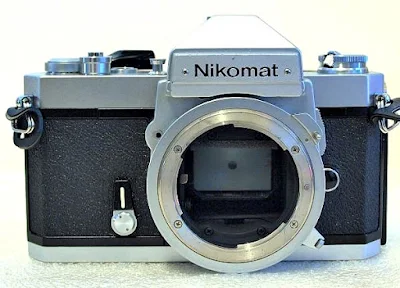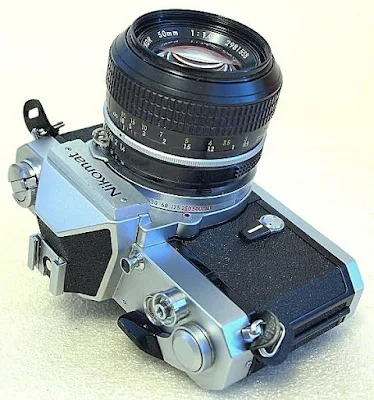The Nikomat FT2 (Nikkormat FT2 in the US), launched in 1975, the final pre-Ai of the Nikomat/Nikkormat F-series cameras from Nikon, is essentially an upgrade of the FTN (1967) with enhancements and added features. The extremely robust all-metal and mechanically controlled manual focus 35mm SLR film camera model with match-needle exposure control was manufactured by Nippon Kogaku K. K. (Nikon) from 1975 to 1977.
The FT2 now comes with a built-in hot shoe, a single screw-threaded 3 mm (PC) flash contact, a new Type K focusing screen, and power sourced from 1.5-volt batteries. Additionally, the "+" and "-" symbols were also added to the display of the top meter read-out. Film ISO adjustment was made easier with a redesigned and lockable slider setting.
Mechanically, the FT2 retains the basic engineering that the FT series comes with. The camera is fitted with a vertical travel metal focal-plane shutter with a speed range from 1 to 1/1000 second and B, X flash sync at 1/125 second, and accepts film ISO speed range from 12 to 1600. The FT2 is also fitted with a mirror-lockup and depth-of-field preview facility, a multiple thread release cable socket, and a variable 8-second delay self-timer.
Introduction to the Nikon Nikkormat FT2, Video 1 of 2
Nikon followed the popular Nikkormat FTn with the FT2. More an evolution than a sequel, the FT2 incorporated user feedback to help improve the design. Touche...
The FT2 accepts most Nikon F and F2 accessories except for non-interchangeable finders, screens, motor drives, and film backs. The camera is compatible with all Ai Nikkor lenses and will work in stop-down exposure measurement with bellows focusing attachments, extension rings, focusing units, preset lenses, auto lenses without coupling prong, and Reflex-Nikkor lenses.
Aperture indexing on the FT2 is still semi-automatic, and lenses must be set at F5.6 so the camera’s meter coupling pin will be aligned with the lens’s meter coupling prong (rabbit ears) when mounting. Rotating the aperture ring all the way back and forth to register the maximum aperture of the lens is part of the procedure.
Basic Camera Features
Since its initial launch, FT-series cameras have earned acknowledgments and accolades for superior built and robust handling. The Nikomat/Nikkormat cameras are proud both as excellent consumer-grade products and have strong professional support as well.
The camera has a fundamentally compact form factor, exceptional build quality, top-rated mechanicals, and an extremely reliable metal-blade Copal Square focal-plane shutter, known for its high X-speed, durability, and accuracy.
The front of the camera, as with the rest of the series, is all but plain with the lens housing mount located slightly off-center to the right of the front plane, with the self-timer rocker switch to its left, and the lens release button on the right edge of the lens mount.
On the mount itself, on the top-right vertical is the mirror-lockup slider switch, and on the left is a small hump with a pointer dot to indicate the shutter speed setting. The shutter speed and film ISO speed dial are concentric on the camera lens mount itself.
On the top plane, from left to right, is the film rewind knob and pull-up film canister release, the meter window which duplicates the TTL exposure reading, and the pentaprism with a built-in hot shoe. To the right of the pentaprism, is the depth of field preview button, the shutter release button, the film counter window, and the film forward crank.
On the back of the top plane level is the viewfinder eyepiece with a screw-in diopter correction lens. The rest of the camera back is occupied by the non-interchangeable hinged film, with its latch release mechanism located on the left shoulder of the film back, below the flash sync socket which is located above it.
On the bottom plate of the camera is the battery chamber with a half-turn to lock the battery chamber cover, tripod socket, and film rewind release button.
The film box, with the film back release latch located on the left shoulder of the camera back, is a standard Nikon quick-load system with the film canister chamber, shutter window, sprocket gear, and the multi-slot take-up spool configuration laid from left to right.
Film Loading and Rewind
The film roll is loaded into the camera by first inserting its canister into the leftmost chamber, pulling the film tab end right across the back, and inserted into one of the inner slots of the take-up spool. The film is wound in the opposite direction of the film crank swing, with the emulsion side up.
Before closing the film back, make sure that the film is properly tensioned across the opening, and that the perforations on the film edge are properly aligned with the sprocket gear. Do the standard 2-blank shots after closing the film back to forward the film to frame 1, and you are ready to go.
To rewind and unload, press the rewind release button on the camera baseplate, and crank the film rewind lever clockwise until the film roll is fully rewound into the film canister. Release the film back and remove the film roll for processing.
Viewfinder Readout
The FT2 is fitted with the new Type K focusing screen with a 3mm split-image rangefinder, 1mm microprism collar, and a 12mm circle to indicate the 60/40 center-weighted metering area.
Metering is biased towards the central area, which turns on when the film advance lever is flipped out about 20° from the body of the camera.
The 'center-the-needle' exposure control system display is located on the lower right side of the viewfinder screen, and the shutter speed display is on a bar below the viewfinder screen.
Mounting The Lens
Before mounting, the aperture opening of Ai lenses is first set to the F5.6 mark, and the coupling pin on the lens housing mount is rotated to the far right.
Insert the lens with the lens meter coupling prong aligned to the coupling pin, and rotate the lens to the left (anti-clockwise) to engage the mount.
Next, continue by turning the aperture ring all the way back and forth again to register the maximum aperture of the lens, indicated by a red index mark on the maximum-aperture scale concentric located just below the coupling pin concentric on the lens housing mount.
Setting Shutter and Film ISO Speed
The shutter speed on the FT2 is set by using the left thumb (while holding the camera cupped in your left hand) on the finger slider of the ring with the setting displayed on the shutter speed bar located at the bottom of the viewfinder screen.
If set manually, align the shutter speed number to the red dot on the top-left front of the lens mount housing.
The ISO speed setting is a slotted index pointer located on the lower part of the shutter speed ring. Adjustments to the film ISO selector are made by first unlocking its position by deftly pulling out the shutter speed selector button slightly, which has a small knob on its end.
The Meter Window
The meter window, a small glass-covered opening located to the right and aft of the film rewind crank, replicates the exposure reading displayed in the viewfinder.
This gadget is a great assist, for example, when you have the camera mounted on a tripod for landscape or posed group shots where you can do the final exposure setting without having to squint your eyes through the viewfinder.
DoF (Depth of Field) Preview
The FT2 (just like the rest of the Nikomat/Nikkormat F series) is also fitted with a DoF (Depth of Field) preview, activated by a button located on the top plane of the camera.
Self-Timer
The variable delay self-timer is activated by turning the timer lever in the anti-clockwise direction to the desired delay duration position. The delay, with the timer set to work with the mirror up, is actuated by the shutter release button.
Battery
The FT2 is powered by a 1.5-volt SR/LR44 button cell battery.
Battery Chamber Cover
A unique design feature of the FT-series, not easily found on other camera makes and models, is the half-turn to open and lock the battery chamber cover. The cap is engraved with the letter O and an arced arrow to show the clockwise half-turn direction to unlock the cap, which pops out for easy replacement of the cell button battery.
Once a new battery is inserted, the cap is pushed in slightly and turned half-around in the anti-clockwise direction to lock. A misunderstanding of this method of use may lead to the cap breaking its lock stay, letting it loose to rotate, and falling off at specific spots of the turn, as seen on a couple of mismanaged units.
Camera Body Weight
The Nikomat FT2 camera's body weight is a hefty 780 grams without batteries.
In Use
In use, the FT2 is definitely a smooth operator. With such an excellent build and superb mechanicals, the camera reminisces a built-for-ever feel to it and is operated with a very smooth and almost shock-less shutter actuation and mirror flap as you release the shutter. Smooth as silk, as you might say.
On a well-maintained unit, film forward is equally smooth, as are all the actions for adjusting the lens aperture and shutter speed ring with the fingers on your left hand, to using the depth-of-field preview and shutter buttons with your right index finger.
These very robust, well-engineered cameras and almost unbreakable cameras, the rest of the FT-series included, are yours for the keep, put to good use, and are equally easy to learn and master even as a beginner camera.
Stick to the formula of having an excellent Nikkor AI lens mounted, and you are not far off from having one of the best camera lens combinations anybody could have wished for.

























No comments:
Post a Comment